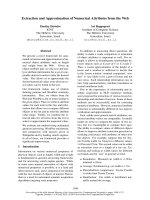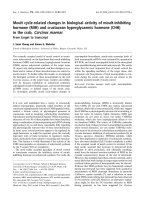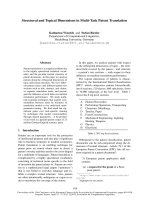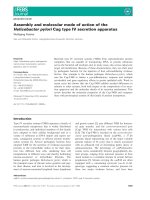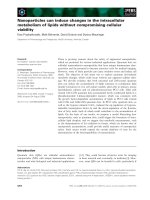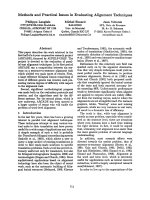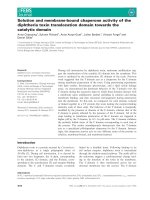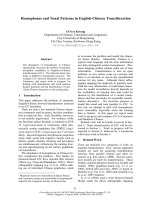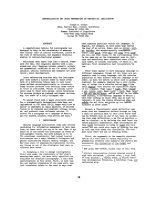Báo cáo khoa học: " Endocrine and Ovarian Changes in Response to the Ram Effect in Medroxyprogesterone Acetate-primed Corriedale Ewes" ppsx
Bạn đang xem bản rút gọn của tài liệu. Xem và tải ngay bản đầy đủ của tài liệu tại đây (197.72 KB, 12 trang )
Ungerfeld R, Carbajal B, Rubianes E, Forsberg M: Endocrine and ovarian changes
in response to the ram effect in medroxyprogesterone acetate-primed corriedale
ewes during the breeding and nonbreeding-season. Acta vet. scand. 2005, 46, 33-44.
– Two experiments were performed to determine the endocrine and ovarian changes in
medroxyprogesterone acetate (MAP)-primed ewes after ram introduction. Experiment 1
was performed during the mid-breeding season with 71 ewes primed with an intravagi-
nal MAP sponge for 12 days. While the control (C) ewes (n = 35) were in permanent
contact with rams, the ram effect (RE) ewes (n = 36) were isolated for 34 days prior to
contact with rams. At sponge withdrawal, all ewes were joined with eight sexually ex-
perienced marking Corriedale rams and estrus was recorded over the next 4 days. The
ovaries were observed by laparoscopy 4-6 days after estrus. Four weeks later, pregnancy
was determined by transrectal ultrasonography. In eight ewes from each group, ovaries
were ultrasonographically scanned; FSH, LH, and estradiol-17ß were measured every
12 hours until ovulation or 96 hours after estrus. The response to the rams was not af-
fected by the fact that ewes had been kept or not in close contact with males before teas-
ing. No differences were found in FSH, LH, estradiol-17ß concentrations, growth of the
ovulatory follicle, onset of estrus, ovulation rate, or pregnancy rate. Experiment 2 was
performed with 14 ewes during the nonbreeding season. Ewes were isolated from rams
for 1 month, and received a 6-day MAP priming. Ovaries were ultrasonographically
scanned every 12 hours, and FSH, LH, estradiol-17ß, and progesterone were measured.
Ewes that ovulated and came into estrus had higher FSH and estradiol-17ß levels before
introduction of the rams than did ewes that had a silent ovulation. The endocrine pattern
of the induced follicular phase of ewes that came into estrus was more similar to a nor-
mal follicular phase, than in ewes that had a silent ovulation. The follicle that finally ovu-
lated tended to emerge earlier and in a more synchronized fashion in those ewes that did
come into estrus. All ewes that ovulated had an LH surge and reached higher maximum
FSH levels than ewes that did not ovulate, none of which had an LH surge. We conclude
that (a) the effect of ram introduction in cyclic ewes treated with MAP may vary de-
pending on the time of the breeding season at which teasing is performed; (b) patterns
of FSH, and estradiol-17ß concentrations, as indicators of activity of the reproductive
axis, may be used to classify depth of anestrus; and (c) the endocrine pattern of the in-
duced follicular phase, which is related to the depth of anestrus, may be reflected in the
behavioral responses to MAP priming and the ram effect.
anestrous depth, gonadotrophin, ram stimulus, teaser rams, ewe.
Acta vet. scand. 2005, 46, 33-44.
Acta vet. scand. vol. 46 no. 1-2, 2005
Endocrine and Ovarian Changes in Response to the
Ram Effect in Medroxyprogesterone Acetate-primed
Corriedale Ewes During the Breeding and
Nonbreeding Season
By R. Ungerfeld
a,b
, B. Carbajal
a
, E. Rubianes
c
, and M. Forsberg
b
a
Departamento de Fisiología, Facultad de Veterinaria, Lasplaces 1550, Montevideo 11600, Uruguay,
b
Centre for
Reproductive Biology, Department of Clinical Chemistry, Faculty of Veterinary Medicine, Swedish University
of Agricultural Sciences, Uppsala, Sweden, and
c
Departamento de Producción Animal, Facultad de Agronomía,
Montevideo, Uruguay.
Introduction
Ovarian and hormonal changes resulting in
ovulation following introduction of males to
previously isolated females have been de-
scribed for several species, including small ru-
minants (for review see Walkden-Brown et al.
1999). In ewes, the ram effect has been exten-
sively used to induce out-of-season estrus in or-
der to obtain births during autumn (Martin et
al. 1986). Introducing rams to previously iso-
lated ewes induces ovulation in some animals,
and these may eventually become pregnant.
The effect is mediated by a rapid increase in
luteinizing hormone (LH) pulse frequency, fol-
lowed by a surge in LH similar to that observed
during the follicular phase of the estrous cycle
(Oldham et al. 1978/1979). Ovarian responses
to the ram effect were recently described using
transrectal ultrasonography (Ungerfeld et al.
2002). The ovarian response may be related to
anestrous depth: we observed a higher LH pulse
frequency and higher FSH levels in ewes that
responded to the ram effect with a luteal phase
than in ewes that did not respond (Ungerfeld et
al. 2000).
The ram effect has also been used to advance
puberty (Oldham & Gray 1984) and shorten
lactational anestrus (Geytenbeek et al. 1984).
However, little is known about the effect of ram
introduction on the estrous response of cyclic
ewes. Pearce & Oldham (1983), using ovariec-
tomized, progesterone-treated ewes during the
breeding season, observed an increase in LH
pulse frequency after ram introduction that was
not affected by progesterone treatment. Cyclic
ewes with an intravaginal sponge containing
medroxyprogesterone acetate (MAP) also re-
spond to ram introduction with an increase in
LH secretion (A.C.O. Evans, personal commu-
nication), which is followed by a concentration
of ovulation and an increase in pregnancy rate
(Lucidi et al. 2001). When compared with ewes
that have been near the pen of the rams, previ-
ously isolated ewes primed with MAP respond
with a shorter latency to onset of estrus and an
improved synchronization of heat (Ungerfeld &
Rubianes 1999). Similarly, an earlier lambing
period was observed in unprimed cyclic ewes
stimulated with rams (Ann Lai 1988). An ad-
vancement in the onset of estrus was also ob-
served, as well as an earlier LH surge and ear-
lier ovulation (Evans et al. 2002).
In anestrous ewes, the ram effect stimulates
ovulation; however, the first ovulation is not ac-
companied by heat. Heat has been reported to
occur concurrently with the first ovulation
when progestogen treatment is used before in-
troduction of the rams (Hunter et al. 1971),
even over 6 days (Ungerfeld et al. 2003). How-
ever, in previous experiments with Corriedale
ewes, we observed that approximately 30-50%
of animals primed with progestins showed their
first estrus 17-20 days later (Ungerfeld et al.
1999, 2003), which was preceded by luteal pro-
gesterone levels, indicating a previous ovula-
tion (Ungerfeld et al. 2003). Similar results
have been reported by Martin et al. (1981), al-
though in their study, sponges were withdrawn
48 hours before introduction of the ram.
The first objective of this study was to deter-
mine if the introduction of rams to MAP-
primed cyclic ewes determines changes in en-
docrine and follicular profiles, estrous onset,
ovulation and pregnancy rates. A second objec-
tive was to characterize the ovarian response
and the endocrine profiles in MAP-primed ewes
stimulated during the non-breeding season, and
to determine if the endocrine stage at ram intro-
duction may affect estrous expression and first
ovulation.
Materials and methods
Experiment 1
The experiment was carried out on a commer-
cial farm near Trinidad, Uruguay (33° SL), dur-
ing the mid-breeding season (April-May). Alto-
34 R. Ungerfeld et al.
Acta vet. scand. vol. 46 no. 1-2, 2005
gether 71 multiparous Corriedale ewes with a
mean weight of 42.3 ± 4.7 kg and a body con-
dition (BC) score of 2.7 ± 0.4 were used. Body
condition was ranked on a scale of 1-5, where 1
= extremely emaciated and 5 = excessively fat;
values are given as means ± standard error of
the mean (SEM).
During the experimental period, ewes grazed on
native pastures. On day -34 (day 0 = ram intro-
duction), the experimental ewes were tagged
and divided into two homogeneous groups with
respect to BC: the ram effect group (n = 36) and
the control group (n = 35). Ewes in the ram ef-
fect group were isolated from rams so that they
could not see, hear, or smell them (minimum
distance: 1,000 m). Ewes in the control group
remained close to the pen where the rams were
kept. Intravaginal sponges containing 60 mg
MAP (Syntex SA) were inserted in ewes of both
groups on day –12. At sponge withdrawal, all
the ewes were mixed and placed in the same
paddock with eight adult, sexually experienced
Corriedale rams fitted with markers. Ewes in
estrus were identified at 12-h intervals, from 12
h to 96 h after introduction of the rams. At 4-6
days after estrus, ovulation and ovulation rate
were assessed by mid-ventral laparoscopy per-
formed under local anesthesia. To determine
pregnancy status, transrectal ultrasonography
using a dual (5/7.5 MHz) linear probe (Pie
Medical 480, Maastricht, The Netherlands) was
performed 4 weeks after estrus.
A detailed study of the ovarian and endocrine
patterns of the follicular phase was conducted
in eight ewes from each group. Daily ultrasono-
graphic observations of ovaries were performed
by the same operator on all ewes from –72 h
(0 h = introduction of the rams) to 0 h, and at
12-h intervals either until ovulation had oc-
curred or until 96 h. Before each ultrasono-
graphic examination, blood samples were col-
lected by jugular venipuncture and allowed to
clot for 1 h at room temperature before being
centrifuged for 10-20 min, and stored at -20°C
until assayed for FSH, LH, and estradiol-17ß.
Experiment 2
Experiment 2 was conducted on a commercial
farm located near Colonia, Uruguay (35° SL),
in November (mid-seasonal anestrus). Fourteen
adult multiparous Corriedale ewes with a mean
weight of 52.7 ± 1.7 kg and a BC score of 3.2 ±
0.1 were used. Ewes had lambed in April-May,
and lambs were withdrawn 2 months before the
experiment started. During the experimental
period, ewes grazed on improved pastures.
From day -30 (day 0 = day on which rams were
introduced), ewes were isolated from rams in
terms of sight, sound, and smell (minimum dis-
tance: 1,000 m) .
On day -6, intravaginal sponges containing 60
mg of MAP were inserted in all ewes. At
sponge withdrawal, ewes were placed together
with three adult, sexually experienced marking
Corriedale rams. Since anestrous Corriedale
ewes submitted to the "ram effect" express
maximum reproductive response when ewes in
estrus are introduced together with the rams
(Rodríguez Iglesias et al. 1991), 10 ewes were
brought into estrus with a 6-day MAP priming
plus 400 IU of eCG (Novormón, Syntex SA,
Buenos Aires, Argentina). Ewes were checked
twice daily from day 0 to day 5 for onset of es-
trus.
Transrectal ultrasonographic examinations of
ovaries were performed every 12 hours, from
–96 h until ovulation occurred or until 120 h.
Blood was collected from the jugular vein of all
animals on days –12 and –8. On day –8, all an-
imals were fitted with indwelling jugular vein
catheters, which were used until day 7 to collect
blood samples. From day –4 to day 0, samples
were obtained every 12 h and from day 0 until
120 h, samples were obtained every 4 h. A sin-
gle sample was obtained on days 8, 11, and 14.
Samples were allowed to clot for 1 h at room
Endocrine and ovarian changes in response to the ram effect 35
Acta vet. scand. vol. 46 no. 1-2, 2005
temperature before being centrifuged for 10-20
min, and the serum was stored at –20°C until
assayed. Samples taken until day 5 were used
for measurement of FSH, LH, and estradiol-
17ß; samples taken from day 5 to day 14 were
measured for progesterone.
Ultrasonographic observations
Ovaries were scanned with a B-mode ultra-
sound scanner (Pie Medical 480, Maastricht,
The Netherlands) equipped with a dual (5/7.5
MHz) linear-array probe. A slightly arched
plastic tube (25 cm long) was fastened to the
transducer cable so that the intrarectally placed
probe could be manipulated externally. During
each examination, a sketch of both ovaries was
made to record the diameter and position of fol-
licles >2 mm in diameter. The observations
were also recorded on video using individual
videocassettes to verify and correct real-time
data. After locations had been recorded, the
sketch was compared with that of the previous
day.
Hormonal measurements and definitions
Progesterone concentration was determined us-
ing a direct solid-phase
125
I RIA method
(Count-A-Count TKPG, Diagnostic Products
Corporation, Los Angeles, CA, USA) with a
sensitivity of 0.3 nmol/L. LH concentrations
were measured in all samples with a liquid-
phase RIA previously validated for ovine serum
(Forsberg et al. 1993); the detection limit was
0.4 µg/L. Concentrations of FSH and estradiol-
17ß were measured in all samples, except the
intensive bleeding period (day -6), from which
only the first and the last sample were included.
Concentrations of FSH were measured with a
liquid-phase RIA previously validated for ovine
serum (Meikle 2001); the detection limit was
0.4 µg/L. Estradiol-17ß was measured using a
direct solid-phase
125
I RIA method (Count-A-
Count TKPG, Diagnostic Products Corpora-
tion, Los Angeles, CA, USA) previously vali-
dated for ovine serum (Meikle 2001); the
sensitivity of the assay was 5.5 pmol/L. The in-
traassay and interassay coefficients of variation
were <10% for all assays.
Luteal activity was defined as the presence of
progesterone concentrations >1.6 nmol/L (0.5
ng/ml) in three or more consecutive samples.
An LH surge was defined as being at least 6
times the value of mean levels. Basal LH con-
centrations before the introduction of the rams
were defined as the mean values of LH.
Statistical analysis
All results are presented as means ± standard
error of the mean (SEM), with a significance
level of α = 5%. Mean intervals from sponge
withdrawal to estrus were compared by
ANOVA; frequencies of ewes in heat were com-
pared by Fisher's exact probability test. Ovula-
tion rate (Experiment 1) and follicular popula-
36 R. Ungerfeld et al.
Acta vet. scand. vol. 46 no. 1-2, 2005
Table 1. Percentages of ewes that showed estrus, length of interval to estrus onset, and ovulation and concep-
tion rates in cyclic ewes primed with intravaginal sponges containing 60 mg of MAP for 12 days. While Control
ewes remained near rams during all the period before joining, ram effect ewes remained isolated from rams dur-
ing that period (Experiment 1).
Group
Estrous ewes Interval to Conception rate
no. (%) estrus onset (h)
Ovulation rate
no. (%)
Control 34/35 (97.1) 51.0 ± 5.4 1.1 ± 0.3 26/34 (76.5)
Ram effect 32/36 (88.9) 52.5 ± 3.9 1.1 ± 0.3 28/32 (87.5)
C = control group; RE = ram effect group.
tions (Experimetn 2) were compared with the
Kruskal-Wallis test The diameter of the largest
follicle was compared with ANOVA, and LH
surge values were compared with ANOVA (Ex-
periment 2). Changes of hormonal concentra-
tions over time for each group of ewes were
compared by ANOVA; hormonal profiles and
the growth profiles of follicles were analyzed
with the general linear model procedure of the
Statistical Analysis System (SAS 1996) using
repeated-measures ANOVA. Hormonal data
were analyzed after normalization by log trans-
formation.
Endocrine and ovarian changes in response to the ram effect 37
Acta vet. scand. vol. 46 no. 1-2, 2005
Fig. 1. A) Diameter of the ovulatory follicle (RE: --; C: -᭜-), and LH levels (RE: -᭹-; C: -᭡-) normalized to
ovulation. B) FSH (RE: --; C: -᭜-) and estradiol-17ß (RE: -᭹-; C: -᭡-) normalized to the LH surge. Ewes were
primed for 12 days during the breeding season with an intravaginal sponge containing 60 mg of MAP. Unlike
control (C) ewes (n = 5), ram effect (RE) ewes (n = 6) were isolated from contact with rams 30 days before
sponge withdrawal.
Results
Experiment 1
There were no significant differences between
the ram effect and control groups regarding per-
centage of estrous ewes, time from sponge
withdrawal to onset of estrus, ovulation rate, or
pregnancy rate. Data are presented in Table 1.
Surges in LH, which were detected in five out of
eight control ewes and in six out of eight ram
effect ewes, occurred at 48.0 ± 6.0 and 48.0 ±
4.2 h, respectively, after sponge withdrawal. All
ewes ovulated, and there was no difference in
LH and growth of the ovulatory follicle (Fig.
1A), or FSH and estradiol-17ß (Fig. 1B) levels
between control and ram effect ewes (P >0.05).
Experiment 2
No ewe showed luteal activity before introduc-
tion of the rams (days -12, -8, and -6).
Ten out of 14 ewes showed an LH surge, that
reached maximum concentrations at 63.6 ± 6.8
h after introduction of the rams. After FSH lev-
els were normalized with respect to the LH
peak, we observed a significant increase in
FSH, which began 6 h before the LH surge and
reached maximum levels concurrently with the
maximum LH concentrations (P <0.05; Fig.
2A).
Five ewes came into estrus, ovulated, and de-
veloped normal luteal phases. Of the remaining
nine ewes, five ovulated and had normal luteal
phases, but did not display heat. The remaining
four ewes did not ovulate or display estrous be-
havior. Ewes were grouped according to their
response: those that came into estrus and ovu-
lated (E-O), those that did not display estrous
behavior but ovulated (NE-O), and those that
did not ovulate and did not show estrus (NE-
NO).
The insertion of the intravaginal sponges (day -
6) did not provoke significant changes in con-
centrations of FSH, LH, and estradiol-17ß (P
>0.1). Thus, concentrations for this period are
presented pooled in Table 2. Concentrations of
FSH and estradiol-17ß before introduction of
the rams differed according to the response pat-
tern. While FSH (Fig. 2B) and estradiol-17ß
concentrations were higher in E-O ewes than in
NE-O and NE-NO ewes in samples obtained
before introduction of the rams, there were no
significant differences in LH basal concentra-
tions.
The mean values for the number of large folli-
cles and the maximum diameter of the largest
follicle during the period before ram introduc-
tion are presented in Table 2. After introduction
of the rams, the diameter of the largest follicle
and the number of follicles >4 mm was similar
between E-O, NE-O, and NE-NO ewes (P
>0.05).The diameter of the largest follicle in-
38 R. Ungerfeld et al.
Acta vet. scand. vol. 46 no. 1-2, 2005
Table 2. Concentrations and characteristics of FSH, LH and estradiol-17b, and number of large follicles
(>4mm) and diameter of the largest follicles before introduction of rams (mean values until the introduction of
the rams) to anestrous ewes primed for 6 days with intravaginal sponges containing 60 mg of MAP. Ewes were
classified as E-O (those that came into estrus and ovulated), NE-O (those with a silent ovulation), and NE-NO
(those that did not come into estrus or ovulate) (Experiment 2).
E-O NE-O NE-NO P
FSH levels (µg/L) 3.3 ± 0.1
a
2.8 ± 0.1
b
2.6 ± 0.3
b
<0.01
LH basal levels (µg/L) 0.86 ± 0.05 0.84 ± 0.04 0.75 ± 0.05 >0.1
Estradiol-17ß levels (pmol/L) 12.6 ± 0.6
a
10.0 ± 0.6
b
9.7 ± 5.3
b
<0.001
Number of follicles > 4mm 0.3 ± 0.1 0.5 ± 0.1 0.5 ± 0.1 >0.1
Diameter of the largest follicle (mm) 3.8 ± 0.1 3.9 ± 0.1 3.9 ± 0.1 >0.1
Different letters within the same row indicate statistically significant differences.
creased significantly after introduction of the
rams (P <0.001), reaching the maximum value
at 36 h (3.9 ± 0.1, 3.8 ± 0.1, 4.3 ± 0.1, 4.8 ± 0.2,
4.8 ± 0.2, and 4.7 ± 0.3 mm, for the period be-
fore rams, at 12, 24, 36, 48, and 60 h, respec-
tively). The number of follicles >4 mm in-
creased significantly (P <0.05) from 24 to 48 h
compared with values before introduction of
the rams (0.4 ± 0.1, 1.0 ± 0.2, and 1.25 ± 0.3 be-
fore introduction of the rams, at 24 and 48 h, re-
spectively).
There were no differences in growth profiles of
the largest follicle between ewes from different
groups after introduction of the rams (P >0.1).
Endocrine and ovarian changes in response to the ram effect 39
Acta vet. scand. vol. 46 no. 1-2, 2005
Fig. 2. Fourteen ewes were isolated from contact with rams for 30 days and primed for 6 days with an intrav-
aginal sponge containing 60 mg of MAP during the nonbreeding season; rams were introduced at sponge with-
drawal. A) FSH (--) and LH levels (-᭡-) normalized to the LH surge (n = 10). B) FSH levels in E-O (--, n =
5), NE-O (-᭡-, n = 5), and NE-NO (-᭜-, n = 4) ewes. (BR = data pooled from the period before the introduction
of the rams.) (Time with respect to the sponge withdrawal is equal to the time for ram's introduction.) E-O ewes
displayed estrous behavior and ovulated after introduction of the rams, NE-O ewes ovulated but did not come
into estrus, and NE-NO ewes neither ovulated nor came into estrus.
However, while in four E-O ewes the follicle
emerged before introduction of the rams, in
four NE-O ewes it emerged after introduction
of the rams (P = 0.06). Moreover, the follicle
that finally ovulated tended to emerge earlier in
E-O (–7.2 ± 7.2 h) than in NE-O (19.2 ± 12.3 h;
P = 0.1) ewes.
While in E-O ewes, there was a significant in-
crease of estradiol-17ß concentration after in-
troduction of the rams (P <0.05), in NE-O and
NE-NO ewes, changes in estradiol-17ß during
this period did not reach statistical significance.
Concentrations from ram introduction until 36
h later (the period where significant changes oc-
curred) are presented in Fig. 3A. Maximum
estradiol-17ß levels tended to be higher in E-O
than in NE-O and NE-NO ewes (Table 3). Dur-
ing the same period, FSH concentrations de-
creased significantly (P <0.05) in the E-O and
NE-O ewes, but no significant differences were
observed in FSH levels in NE-NO ewes (Fig.
3B). When normalized to the LH surge, estra-
diol-17ß concentrations tended to be higher in
E-O than in NE-O, from 30 (17.3 ± 1.8 vs. 11.2
± 1.8 pmol/L; P = 0.06), 24 (16.0 ± 2.4 vs. 10.0
± 1.6 pmol/L; P = 0.1), and 18 h (20.7 ± 3.7 vs.
13.0 ± 1.1 pmol/L; P = 0.08) before the LH
surge, and were significantly higher at the time
of the surge (18.8 ± 3.1 vs. 10.8 ± 1.2 pmol/L;
P <0.05) in E-O than in NE-O ewes, respec-
tively.
All ewes in the E-O and NE-O groups, but none
in the NE-NO group, showed an LH surge. The
surge tended to be earlier and attained higher
concentrations in E-O than in NE-O ewes, and
ovulation tended to be earlier in E-O than in
NE-O ewes (Table 3). Maximum FSH levels
tended to be higher in E-O and NE-O ewes than
in NE-NO ewes (Table 3).
Discussion
In the breeding season (Experiment 1), the en-
docrine or ovarian changes found after intro-
duction of the ram stimulus were similar in
ewes that had been totally isolated from males
before the stimulation and in ewes that had been
kept in close contact with them. The fact that
the ovulation was observed in all ewes, while
the LH surge in only 11 ewes may be explained
by the sampling regime (each 12 h), missing the
remaining 5 surges between two consecutive
bleedings. The lack of differences between
stimulated and unstimulated ewes is in contrast
to recently reported results (Ann Lai 1988,
Ungerfeld & Rubianes 1999, Evans et al.
2002). However, in other studies it was ob-
served that the introduction of rams induces an
increase of LH pulsatility in cyclic ewes with an
40 R. Ungerfeld et al.
Acta vet. scand. vol. 46 no. 1-2, 2005
Table 3. Concentrations and characteristics of FSH, LH, and estradiol-17b after introduction of rams to ane-
strous ewes primed for 6 days with intravaginal sponges containing 60 mg of MAP. (Abbreviations as in Table
2.) (Experiment 2).
E-O NE-O NE-NO P
LH surge 5/5 5/5 0/4 <0.001
LH surge concentration (µg/L) 21.3 ± 5.6 11.5 ± 1.9 0.07
Time to LH surge (h) 51.6 ± 8.4 75.6 ± 7.9 0.07
Time to ovulation (h) 67.2 ± 6.1 94.0 ± 8.9 <0.1
Mean FSH concentration (µg/L) 3.1 ± 0.1 2.7 ± 0.1 2.5 ± 0.4 <0.1
Maximum FSH concentration (µg/L) 5.1 ± 0.4
a
4.3 ± 0.1
a
3.4 ± 0.5
b
<0.1
Mean estradiol-17ß levels (pmol/L) 13.4 ± 1.2 13.3 ± 2.1 10.5 ± 1.3 <0.1
Maximum estradiol-17ß levels (pmol/L) 23.8 ± 3.3 15.8 ± 1.6 17.5 ± 1.9 0.09
Different letters within the same row indicate statistically significant differences.
intravaginal MAP sponge, but it was followed
by a lower pregnancy rate in subsequent estrus
(Evans et al. 2004). The diverging results could
be attributed to the physiological state of ewes
in relation to when in the breeding season the
experiment was performed. While previous ob-
servations in Corriedale ewes (Ungerfeld & Ru-
bianes 1999) were made at the onset of the
breeding season, the present experiment was
performed in the mid-breeding season, when
ewes spontaneously display their maximum re-
productive activity. As in our experiment one
aim was to determine possible effects of ram in-
troduction in estrous onset, ovulation rate and
pregnancy rate, we did not include a permanent
isolated group. Thus, it remains to be eluci-
dated if the introduction of rams may induce
changes in the endocrine patterns or on the fol-
licular development compared with those val-
ues in permanent isolated ewes.
In the non-breeding season (Experiment 2), we
observed that concentrations of FSH and estra-
diol-17ß were higher before ram introduction in
ewes that finally came into heat coincident with
ovulation (E-O ewes). Although there are no
clear parameters to characterize "deep" or
Endocrine and ovarian changes in response to the ram effect 41
Acta vet. scand. vol. 46 no. 1-2, 2005
Fig. 3. Estradiol-17ß (A) and FSH (B) concentrations in 14 ewes that were isolated from contact with rams for
30 days, and primed for 6 days with an intravaginal sponge containing 60 mg of MAP during the nonbreeding
season; rams were introduced at sponge withdrawal. Time with respect to the sponge withdrawal is equal to
the time for ram's introduction. Ewes ovulated and came into estrus (n = 5; --), ovulated without estrus (n = 5;
-᭡-), or neither ovulated nor came into estrus (n = 4; -᭹-). BR = pooled values from the period before rams were
introduced.
"shallow" anestrus, our results let us to suggest
that the endocrine patterns of estradiol-17b and
FSH, as well as LH pulsatility (Martin et al.
1985, Ungerfeld et al. 2000) may be useful
tools to characterize anestrous depth. The use
of arbitrary percentages, such as percentage of
animals that are cyclic to differentiate deep
from shallow or transitional anestrus (Signoret
et al. 1982), is useful for flock studies, but such
estimates do not take into account the physio-
logical differences existing within noncyclic
ewes. Martin & Scaramuzzi (1983) proposed
that the "responsiveness" to the ram effect
could be used to differentiate deep from shal-
low anestrus, while Restall (1992) suggested
that use of the ovulation rate, LH pulse fre-
quency, or basal LH levels would differentiate
these "states", because these parameters better
reflect variation in hypothalamic activity. How-
ever, specific values from any hormone that
may be used to characterize the depth of anoe-
strous of an individual female should be con-
sidered only against data from a specific flock,
because basal hormone concentrations may dif-
fer with factors such as breed, the stage of the
anoestrous season, or the nutritional status of
the animals.
Ewes that came into estrus also showed a pre-
ovulatory increase in estradiol-17ß concomi-
tant with a fall in FSH concentrations (Good-
man et al. 1981), which is similar to what
occurrs before ovulation in a normal estrous cy-
cle (Baird et al. 1976). In the same ewes, the
emergence of the follicle that finally ovulated,
the LH surge, and ovulation all occurred or
tended to occur earlier. We can speculate that
this difference in the endocrine response may
have been a consequence of a high sensitivity of
the hypothalamus-pituitary axis during shallow
anestrus that determine that in more ewes a fol-
licle that was present when rams were intro-
duced finally ovulate. In ewes that were in
deeper anestrus, the increase in estradiol-17ß
did not reached significant differences and the
LH surge and ovulation were delayed until a
new follicle grew, suggesting the need for a
more sustained stimulus before their reproduc-
tive system could respond, and determining a
more widespread ovulation.
In agreement with reports from Poindron et al.
(1980) and Ungerfeld et al. (2002), ewes that
responded with an LH peak showed an increase
in FSH levels (Experiment 2). As those experi-
ments were performed with unprimed ewes, our
results extends the information to the response
of anestrous progestogen-primed ewes stimu-
lated with rams.
We conclude that the effect of ram introduction
in cyclic ewes treated with MAP may vary de-
pending on the time of the breeding season at
which teasing is performed. While anestrous
ewes with higher spontaneous activity of the
hypothalamus-pituitary-ovarian axis will re-
spond to MAP primings and the ram effect with
a follicular phase similar to that observed dur-
ing a normal estrous cycle, and will come in es-
trus concurrently with ovulation, those in a
deeper anestrus would show a less intensive en-
docrine response , would ovulate in a more dis-
persed way, and would not come into estrus.
Acknowledgements
We thank Daniel Laborde and Ademar Negrin, own-
ers of the farms on which the experiments were per-
formed; Andrea Pinczak, Leticia Silva, and Mariana
Laca for help with animal management; Ignacio
Videla (Syntex SA, Buenos Aires, Argentina) for
providing us with the sponges and Novormón; and
Ricardo Rodríguez Iglesias for laparoscopic observa-
tions. Thanks are also due to M A. Carlsson and Å.
Karlsson for RIA analysis, and to Dr. A.F. Parlow and
Dr. J. Roser for supplying hormone and antibody
preparations for the LH and FSH assays. Financial
support was given by CIDEC (Facultad de Veteri-
naria, Uruguay), CSIC (Universidad de la Republica,
Uruguay), the Department of Clinical Chemistry,
SLU (Uppsala, Sweden), and the FNI (CONICYT,
Uruguay).
42 R. Ungerfeld et al.
Acta vet. scand. vol. 46 no. 1-2, 2005
References
Ann Lai SC: Behavioral enhancement of ewe lamb
reproduction through use of the "ram effect".
Master in Science Thesis. Faculty of the Graduate
School of Cornell University, USA, 1988, 108 p.
Baird DT, Land RB, Scaramuzzi RJ, Wheeler AG: En-
docrine changes associated with luteal regression
in the ewe: the secretion of ovarian oestradiol,
progesterone, and androstenedione and uterine
prostaglandin F2a throughout the oestrous cycle.
J. Endocrinol. 1976, 69, 275-286.
Evans ACO, Duffy P, Crosby TF, Hawken PA, Boland
MP, Beard AP: Effect of ram exposure at the end
of progesterone treatment on estrus synchronisa-
tion and fertility during the breeding season in
ewes. Anim. Reprod. Sci. 2004, 84, 349-358.
Evans ACO, Duffy P, Quinn KM, Beard AP, Crosby
TF, Boland MP: Introduction of a ram three days
before progestagen sponge withdrawal decreases
fertility and alters the timing of oestrus, the LH
surge and ovulation in ewes. Proc. Sixth Interna-
tional Symposium on Reproduction in Domestic
Ruminants, Crieff, Scotland, August 14-17, 2002,
p A22.
Forsberg M, Tagle R, Madej A, Molina JR, Carlsson
M-A: Radioimmunoassay of bovine, ovine and
porcine LH with a monoclonal antibody and a hu-
man tracer. Acta Vet. Scand. 1993, 34, 255-262.
Geytenbeek PE, Oldham CM, Gray SJ: The induc-
tion of ovulation in the postpartum ewe. Proc.
Aust. Soc. Anim. Prod. 1984, 15, 353-356.
Goodman RL, Pickover SM, Karsch FJ: Ovarian
feedback control of follicle-stimulating hormone
in the ewe: evidence for selective suppression.
Endocrinology 1981, 108, 772-777.
Hunter GL, Belonje PC, Van Niekerk CH: Synchro-
nized mating and lambing in spring-bred Merino
sheep: the use of progestogen-impregnated intra-
vaginal sponges and teaser rams. Agroanimalia
1971, 3, 133-140.
Lucidi P, Barboni B, Mattioli M: Ram-induced ovu-
lation to improve artificial insemination effi-
ciency with frozen semen in sheep. Theriogenol-
ogy 2001, 55, 1797-1805.
Martin, G.B., Cognié, Y., Schirar, A., Nunes-Ribeiro,
A., Fabre-Nys, C. & Thiéry, J C: Diurnal varia-
tion in the response of anoestrous ewes to the ram
effect. J. Reprod. Fertil. 1985, 75, 275-284.
Martin GB, Oldham CM, Cognie Y, Pearce D: The
physiological responses of anovulatory ewes to
the introduction of rams - a review. Livest. Prod.
Sci. 1986, 15, 219-247.
Martin GB, Scaramuzzi RJ: The induction of oestrus
and ovulation in seasonally anovular ewes by ex-
posure to rams. J. Steroid. Biochem. 1983, 19,
869-875.
Martin GB, Scaramuzzi RJ, Lindsay DR: Induction of
ovulation in seasonally anovular ewes by the in-
troduction of rams: effects of progesterone and
active immunization against androstenedione.
Aust. J. Biol. Sci. 1981, 34, 569-575.
Meikle A: Reproductive endocrinology of prepuber-
tal and anestrous ewes. Regulation of uterine sex
steroid receptors by ovarian hormones and effects
of estradiol on gonadotropin secretion and follic-
ular growth. Ph.D. Thesis, Swedish University of
Agricultural Sciences, Uppsala, Sweden, 2001,
51 p.
Oldham CM, Gray SJ: The 'ram effect' will advance
puberty in 9-10 month old Merino ewes indepen-
dent of their season of birth. Proc. Aust. Soc.
Anim. Prod. 1984, 15, 727.
Oldham CM, Martin GB, Knight TW: Stimulation of
seasonally anovular Merino ewes by rams. I. Time
from introduction of the rams to the preovulatory
LH surge and ovulation. Anim. Reprod. Sci.
1978/1979, 1, 283-290.
Oussaid B, Cognie Y, Mariana JC: Ovarian stimula-
tion following repeated injections of LH or LH +
FSH in Ile-de-France sheep in early and mid-sea-
sonal anoestrus. Anim. Reprod. Sci. 1993, 31, 83-
98.
Pearce DT, Oldham CM: Ram effect in the breeding
season. Proc. Aust. Soc. Rep. Biol., Canberra,
Australia, September 4-7, 1983, p 49.
Poindron P, Cognie Y, Gayerie F, Orgeur P, Oldham
CM, Ravault JP: Changes in gonadotrophins and
prolactin levels in isolated (seasonally or lacta-
tionally) anovular ewes associated with ovulation
caused by introduction of rams. Phys. Behav.
1980, 25, 227-236.
Restall BJ: Seasonal variation in reproductive activ-
ity in Australian goats. Anim. Reprod. Sci. 1992,
27, 305-318.
Rodríguez Iglesias RM, Ciccioli N, Irazoqui H, Ro-
driguez BT: Importance of behavioural stimuli in
ram-induced ovulation in seasonally anovular
Corriedale ewes. Appl. Anim. Behav. Sci. 1991,
30, 323-332.
SAS: 1996. Statistical Analysis Systems, Version
6.12.
Signoret JP, Fulkerson WJ, Lindsay DR: Effective-
ness of testosterone-treated wethers and ewes as
teasers. Appl. Anim. Ethol. 1982, 9, 37-45.
Endocrine and ovarian changes in response to the ram effect 43
Acta vet. scand. vol. 46 no. 1-2, 2005
Ungerfeld R, Pinczak A, Forsberg M, Rubianes E:
Response of Corriedale ewes to the "ram effect"
after primings with medroxyprogesterone, fluoro-
gestone, or progesterone in the non-breeding sea-
son. Acta Vet. Scand. 1999, 40, 299-305.
Ungerfeld R, Pinczak A, Forsberg M, Rubianes E:
Parámetros para determinar la profundidad del
anestro estacional en la oveja. [Parameters to de-
termine anestrus depth in sheep.] Quinta Reunión
Latinoamericana de Cátedras de Fisiología Vet-
erinaria, La Plata, Argentina, 14-15 de diciembre,
2000. [Fifth Latin American Veterinary Physiol-
ogy Departments Meeting, La Plata, Argentina,
December 14-15, 2000.]
Ungerfeld R, Pinczak A, Forsberg M, Rubianes E:
Ovarian and endocrine responses of Corriedale
ewes to ram effect in the non-breeding season.
Can. J. Anim. Sci. 2002, 82, 599-602.
Ungerfeld R, Rubianes E: Estrous response to ram ef-
fect in Corriedale ewes primed with medroxypro-
gesterone during the breeding season. Small
Rum. Res. 1999, 32, 89-91.
Ungerfeld R, Suárez G, Carbajal B, Silva L, Laca M,
Forsberg M, Rubianes E: Medroxyprogesterone
primings and response to the ram effect in Cor-
riedale ewes during the non-breeding season.
Theriogenology 2003, 60, 35-45.
Walkden-Brown SW, Martin GB, Restall BJ: Role of
male-female interaction in regulating reproduc-
tion in sheep and goats. J. Reprod. Fertil. (Suppl.)
1999, 52, 243-257.
Sammanfattning
Baggeffektens inverkan på könshormonnivåer och
follikeldynamik hos Corriedale tackor som behand-
lats med medroxyprogesteronacetat (MAP) under
och utanför parningssäsongen.
Experiment 1 genomfördes under parningssäsongen
med 71 tackor som behandlats intravaginalt med
MAP under 12 dagar. De tackor som fungerade som
kontroller (n=35) var i ständig kontakt med baggar
medan tackorna i försöksgruppen (n=36) hölls isole-
rade från baggar i 34 dagar. Efter avslutad behandling
med MAP sammanfördes kontroll- och försöksgrup-
perna och 8 sexuellt erfarna baggar. Tecken på brunst
övervakades under de 4 följande dagarna och hos de
tackor som visade brunst undersöktes äggstockarna
med laparaskopi 4-6 dagar efter visad brunst. Fyra
veckor senare gjordes en dräktighetsundersökning
med ultraljud. Hos 8 tackor från kontroll- och för-
söksgrupp som visat brunst undersöktes äggstock-
arna med ultraljud var 12 timme samtidigt som
blodprov togs för bestämning av FSH, LH och östra-
diol 17ß. Detta pågick fram till ägglossning eller till
96 timmar efter visad brunst. Av resultaten kunde
man inte utläsa någon skillnad i om tackorna varit
isolerade från baggkontakt eller inte. Det framkom
inte heller några skillnader mellan grupperna i hor-
monkoncentrationer, tillväxt av den ovulatoriska fol-
likeln, när brunsten startade, ovulationsfrekvens eller
dräktighetsresultat.
Experiment 2 genomfördes med 14 tackor utanför
parningssäsongen. Tackorna hölls isolerade från bag-
gar under 1 månad. De sista 6 dagarna innan baggar
återfördes till gruppen behandlades tackorna under 6
dagar intravaginalt med MAP. Innan baggarna åter-
förts till gruppen, påbörjades undersökning av
äggstockarna med ultraljud var 12 timme och blod-
prov togs för bestämning av FSH, LH, östradiol17ß
och progesteron. Resultaten visade att de tackor som
kom i brunst hade högre koncentrationer av FSH och
östradiol17ß innan baggarna återfördes till gruppen.
Det indikerar att dessa båda hormoner skulle kunna
användas för att bedöma hur djupt anöstral en tacka
är utanför parningssäsongen. Den follikelfas som in-
ducerades av baggeffekten liknade hormonellt en
normal follikelfas under parningssäsong. Hos alla
tackor som ovulerade föregicks ägglossningen av
höga halter av LH och FSH.
44 R. Ungerfeld et al.
Acta vet. scand. vol. 46 no. 1-2, 2005
(Received July 13, 2004; accepted February 16, 2005).
Reprints may be obtained from: R. Ungerfeld, Center for Reproductive Biology, Department of Clinical Che-
mistry, Faculty of Veterinary Medicine, Swedish University of Agricultural Sciences, P.O. Box 7038, S-750 07
Uppsala, Sweden. E-mail: , tel: +598 (2) 6286955; fax: +598 (2) 6280130.
